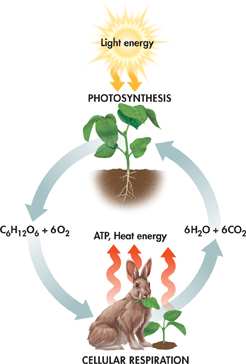Comparing Photosynthesis and Cellular Respiration
 What is the relationship between photosynthesis and cellular respiration?
What is the relationship between photosynthesis and cellular respiration?
If nearly all organisms break down food by the process of cellular respiration, why doesn't Earth run out of oxygen? Where does all of the carbon dioxide waste product go? How does the chemical energy stored in food get replaced? As it happens, cellular respiration is balanced by another process: photosynthesis. The energy in photosynthesis and cellular respiration flows in opposite directions. Look at Figure 9–3 and think of the chemical energy in carbohydrates as money in the Earth's savings account. Photosynthesis is the process that “deposits” energy. Cellular respiration is the process that “withdraws” energy. As you might expect, the equations for photosynthesis and cellular respiration are the reverse of each other.
On a global level, photosynthesis and cellular respiration are also opposites.  Photosynthesis removes carbon dioxide from the atmosphere, and cellular respiration puts it back. Photosynthesis releases oxygen into the atmosphere, and cellular respiration uses that oxygen to release energy from food. The release of energy by cellular respiration takes place in nearly all life: plants, animals, fungi, protists, and most bacteria. Energy capture by photosynthesis, however, occurs only in plants, algae, and some bacteria.
Photosynthesis removes carbon dioxide from the atmosphere, and cellular respiration puts it back. Photosynthesis releases oxygen into the atmosphere, and cellular respiration uses that oxygen to release energy from food. The release of energy by cellular respiration takes place in nearly all life: plants, animals, fungi, protists, and most bacteria. Energy capture by photosynthesis, however, occurs only in plants, algae, and some bacteria.

FIGURE 9–3 Opposite Processes Photosynthesis and cellular respiration can be thought of as opposite processes. Compare and Contrast Exactly how is the equation for photosynthesis different from the equation for cellular respiration?
d9.1 Assessment

-
Review Why do all organisms need food?
Relate Cause and Effect Why do macromolecules differ in the amount of energy they contain?
-
Review Write the overall reaction for cellular respiration.
Apply Concepts How does the process of cellular respiration maintain homeostasis at the cellular level?
-
Review In what ways are cellular respiration and photosynthesis considered opposite processes?
Use Analogies How is the chemical energy in glucose similar to money in a savings account?
BUILD VOCABULARY
The Greek word glukus means “sweet,” and the Latin word lysis refers to a process of loosening or decomposing. Based on this information, write a definition for the word glycolysis.

Table of Contents
- Formulas and Equations
- Applying Formulas and Equations
- Mean, Median, and Mode
- Estimation
- Using Measurements in Calculations
- Effects of Measurement Errors
- Accuracy
- Precision
- Comparing Accuracy and Precision
- Significant Figures
- Calculating With Significant Figures
- Scientific Notation
- Calculating With Scientific Notation
- Dimensional Analysis
- Applying Dimensional Analysis




